#historical venetian women
Explore tagged Tumblr posts
Text
IT'S TIME YOU ALL HEARD ABOUT MY GIRL ARCANGELA TARABOTTI, SALTIEST NUN IN CHRISTENDOM

So, I first heard about Arcangela Tarabotti while I was doing the study for my novella THE CITY BEYOND THE GLASS, which is set in Renaissance Venice and inspired by a real historical practice: At one point during the sixteenth century, nearly sixty percent of all the noble women in Venice lived in convents. And the vast majority of them were there against their will.
For complex dynastic reasons (or basically…money and prestige), only one son and one daughter in each generation of Venetian noble families were permitted to marry during this period. The remaining sons resorted to the famous Venetian courtesans to find the companionship which was denied them in marriage, while the spare daughters were locked into convents. The system was unsustainably wasteful and had to be abandoned within a few generations, but by that time it was already too late - many of the old patrician families of Venice were already going extinct. (You can read more on this in Jutta Gisela Sperling’s book Convents and the Body Politic in Late Renaissance Venice).
While it lasted, the system had plenty of opponents. In 1619, Patriarch Giovanni Tiepolo said, "More than two thousand patrician women…live in this city locked up in convents as if in a public tomb. …They are noblewomen, raised and nurtured with the highest delicacy and respect so that if they were of the other sex, they would command and govern the world."
Even when they have suffered oppression, women throughout history have challenged the status quo, and the women of Venice were no different. Arcangela Tarabotti is the foremost example.
Arcangela was just 11 years old when her father sent her to the convent of Sant'Anna. He considered her to be unmarriageable because she had a physical disability, which she had in fact inherited from him. She would spend the rest of her life there, taking vows as a nun in 1623…a fact about which she was in a white-hot fury.
"Why, then, do you defy the works of the Most Just One by decreeing that many women should live all together, alike in dress, dwelling place, food, and conduct, when the Lord of Lords makes it a miracle of His infinite wisdom for all things He created to be different? Why do you want to bend to your whim contrasting wills created so by nature? It is nothing less than wanting to change and correct the deeds of a Creator who cannot err."
During her early years in the cloister, Arcangela gained a reputation for rebellion and outspokenness. At one stage, it took a direct command from the Patriarch himself to force her to cut her hair. Despite this, Arcangela was able to access a high standard of education at the convent and became a philosopher and writer, corresponding with an impressive network of the thinkers of her day. She wrote multiple works critiquing the misogyny entrenched in Venetian society - including a scorching expose titled Paternal Tyranny.
“Only hell itself bears a likeness to the suffering of these enforced slaves of Christ," Arcangela wrote concerning the Venetian women imprisoned in nunneries. "Over the gate of Hell, Dante says, are inscribed the words ‘Abandon every hope, who enter here.’ The same could be inscribed over the portals of convents.”
Contrary to the polemicists of her day, Arcangela maintained that women were fully equal to men and even argued that they should be able to become lawyers and judges. "Both male and female were born free, bearing with them, like a precious gift from God, the priceless bounty of free choice. If in God’s eyes woman is not less privileged than you with respect to her physical or spiritual qualities, why do you wish her to seem created with such great inequality, you enemies of the truth, proclaiming her to be subject to your impulsive, mad whims? In short, woman is deserving of less respect than you only when you have reduced her to this state by your scheming."
"When women are seen with pen in hand, they are met immediately with shrieks commanding a return to that life of pain which their writing had interrupted, a life devoted to the women's work of needle and distaff," she argued.
Tarabotti maintained that she did not condemn all men simply for being men: "Stricken by a guilty conscience, some men will say that I speak with excessive temerity about all men in general. They are greatly mistaken. If they behave justly, they will be protected from my attacks and those of others. I separate the just from the wicked (who are the subject of my discourse), since not all men are bad and not all women are good."
As a keen amateur historian, I’m accustomed to wincing when people assume that all women living before about 1920 were ignorant, oppressed, and unable to inherit or control property (as if world history was not long and diverse and filled with creative, bold, and influential women). For a limited time during the Renaissance, however, things really were incredibly bad for Venetian women. To find out more about Arcangela and her times, I highly recommend Letizia Panizza's translation of PATERNAL TYRANNY, published in 2004 by the University of Chicago Press!
#history#renaissance history#venice#venetian history#women's history#renaissance women#historical fiction#renaissance#17th century#1600s#medieval women#women in history#feminism
336 notes
·
View notes
Text
Sewing mid-16th century Venetian dress in doll scale
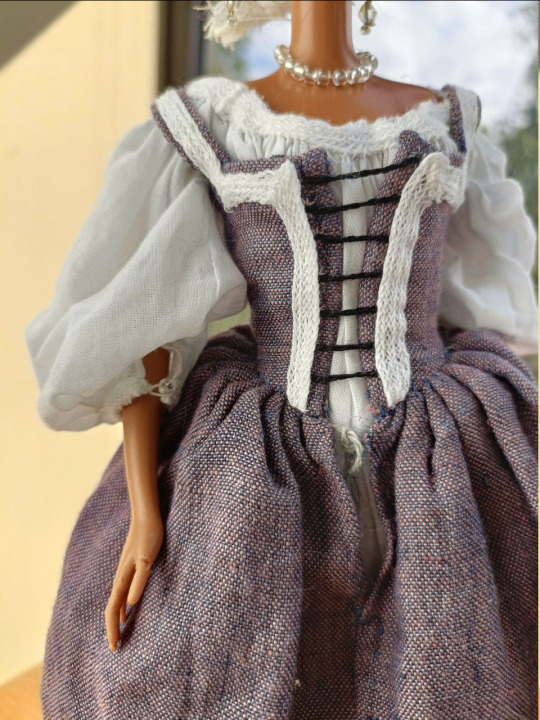
My parents moved from my childhood home, so I needed to finally take all my old toys I want to keep to store myself, including my dolls. For a long while I've been thinking it might by fun to sew tiny historical clothing for dolls. I love watching doll customization videos, they are so satisfying, and I just really love it, when there's a normal sized thing and then you make it tiny. Especially if it's still functional and made from correct materials. I can't explain it better than tiny versions of bigger things just make me vibrate on higher level. Now that I have my dolls in my home and a box full of fabric scraps, I have everything I need to just start sewing. So I did. And it was extremely fun. I have already started working on a 1890s doll outfit.
This will show my age (not that it doesn't read in my bio), but my dolls are all mainly My Scenes. I was Team My Scene in the early 2000s Bratz vs. My Scene wars. I did not like the proportions of Bratzes. All my My Scenes are Madison, she was my girl.
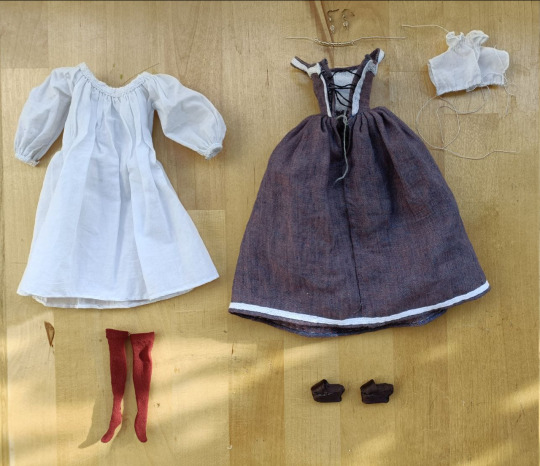
Here's all the items I made. I tried to use as much historical methods as was possible on doll scale and hand-sewed everything. I made a shift, hose, dress, necklace, earrings, partlet and shoes. I did almost make detachable sleeves, but I wasn't happy with them and I will need to remake them. It took me so long to finish one sleeve and I was very frustrated when I wasn't happy with the result, so I will need some time to make a second attempt.
Underlayer
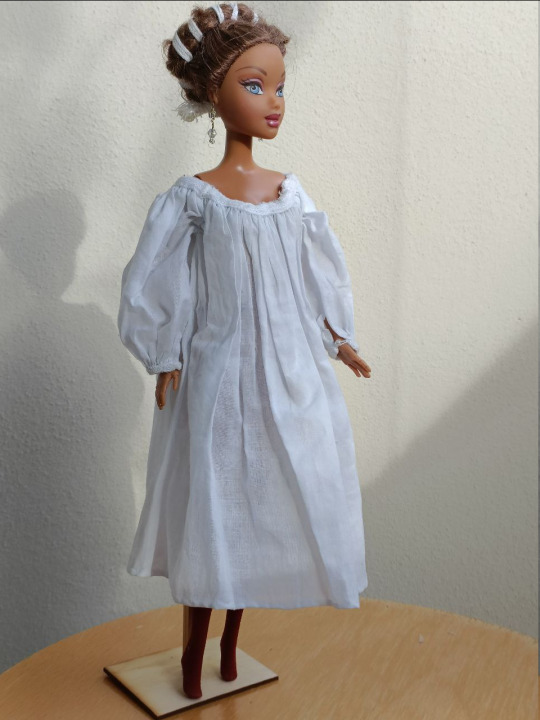
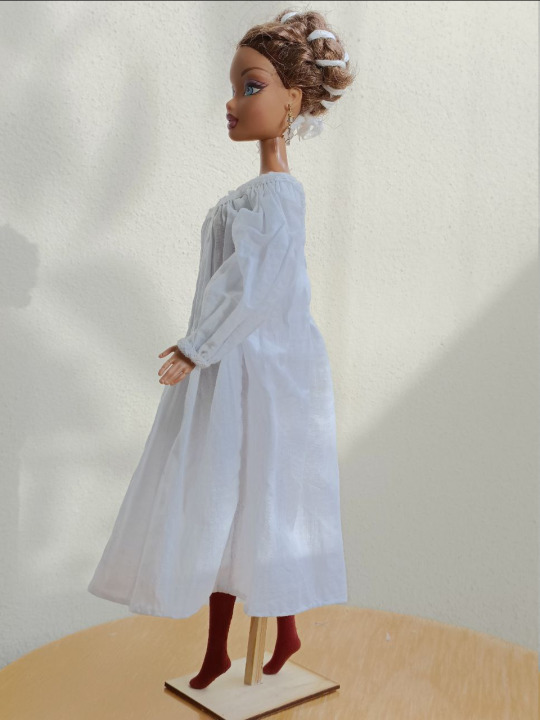
I have finer white cotton than linen so I used the cotton for the shift and partlet, even though cotton wasn't really used widely at the time, definitely not in underwear, but it worked better in this scale. I didn't have thin enough wool for the hose, so I used fabric from my old thin stockings. Knitted stockings were not quite yet a thing so that's not very accurate, but that's the best I got. I choose red since red hose seemed to have been pretty common based on Venetian paintings, where the hose are shown. I used tiny beads I had lying around as buttons for the sleeves.
I'm not super happy with the neckline. I couldn't come up with a good way to finish gathered neckline on this scale without making it bulky. In future I will try something else.
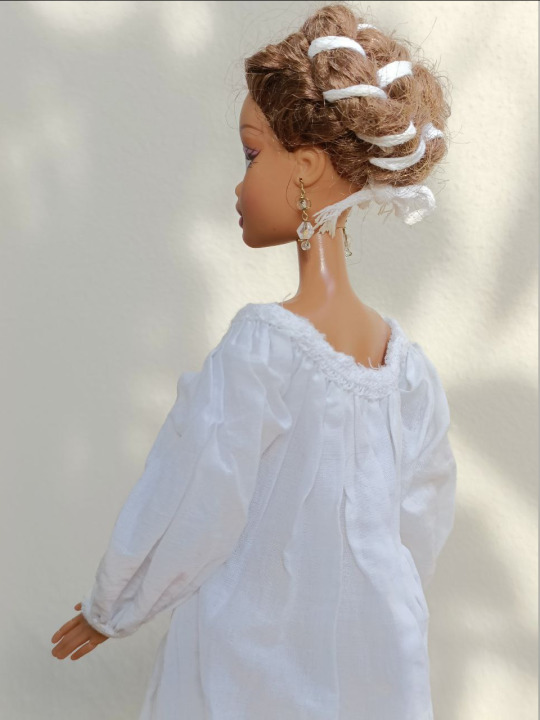
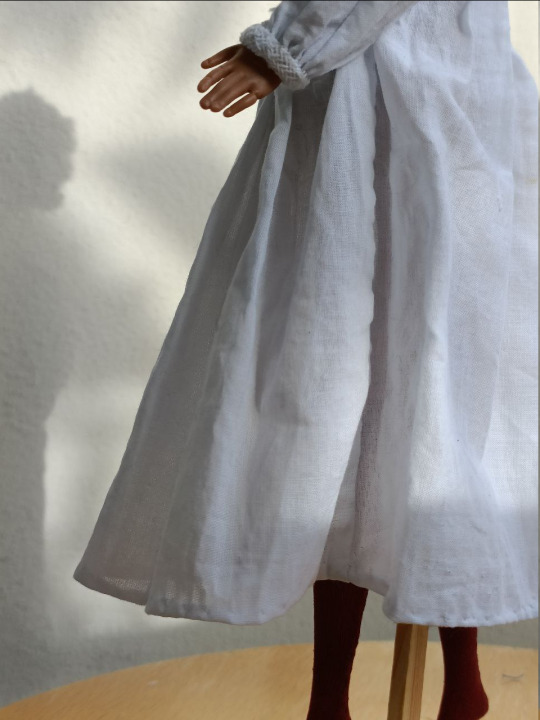
Overgarments
Dress
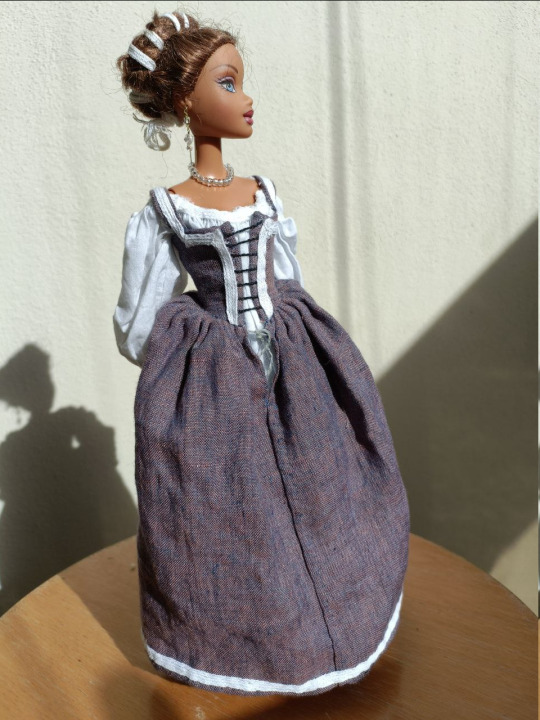
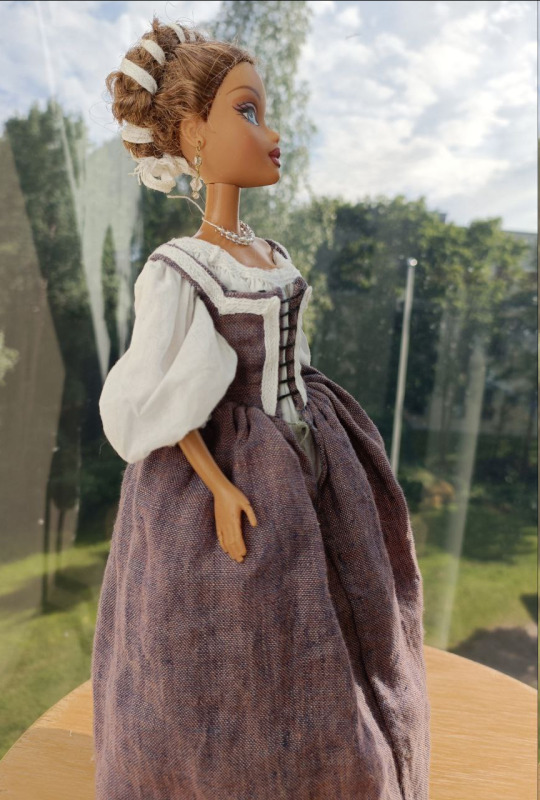
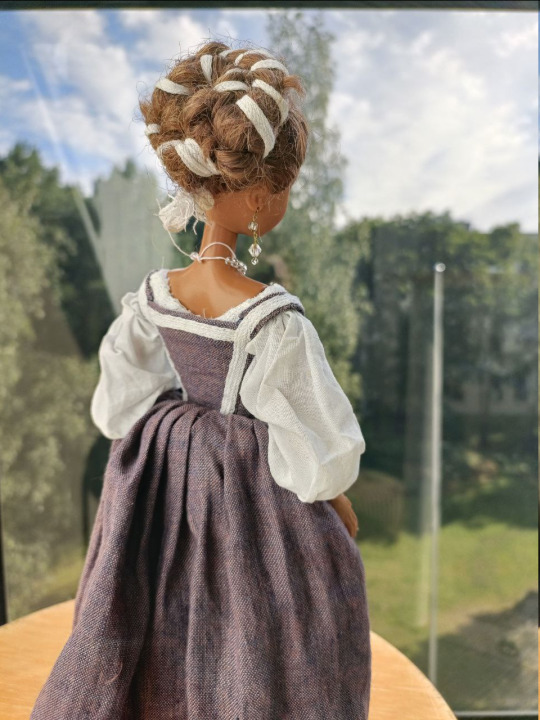
The dress itself is made from the remaining scraps of the lovely Latvian linen I bought many years ago from Riga and have already made several garments from. The skirt is cartridge pleated, though the pleats at places behave a little weirdly due to the scale. I used semi heavy linen as lining and finished the panels separately as was typical in 16th century. I didn't use any boning equivalent, but I use cording to reinforce the laced opening. I of course sewed tiny lacing holes, which was very fun. The cord for the lacing I plaited from heavy thread.


Here's couple of examples from 1550s and 1560s Venice I used as basis for the dress.

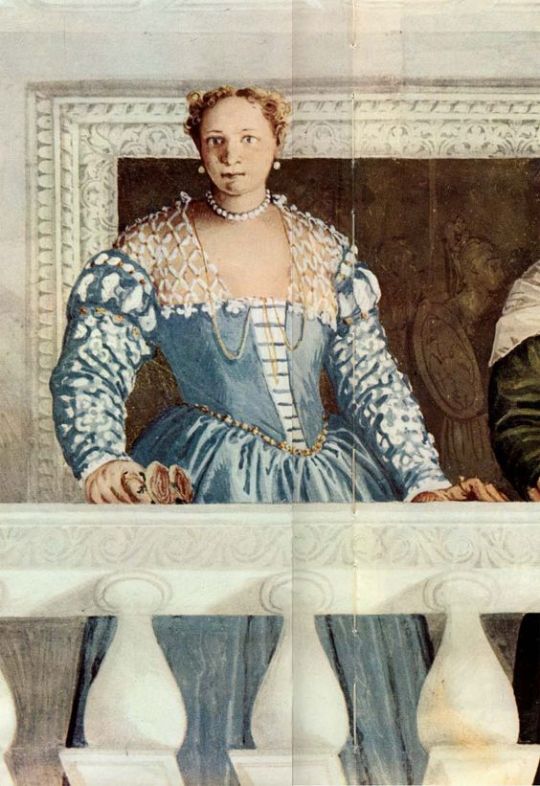
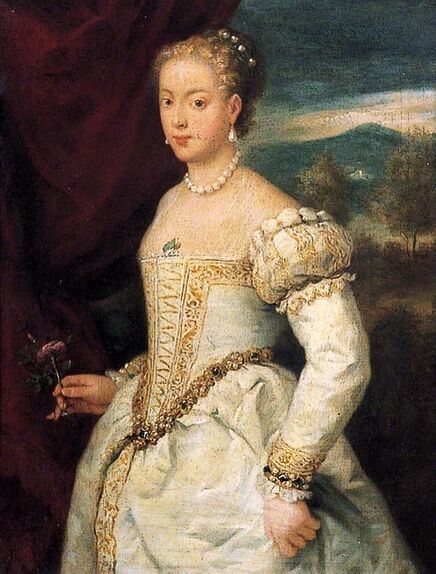
Partlet
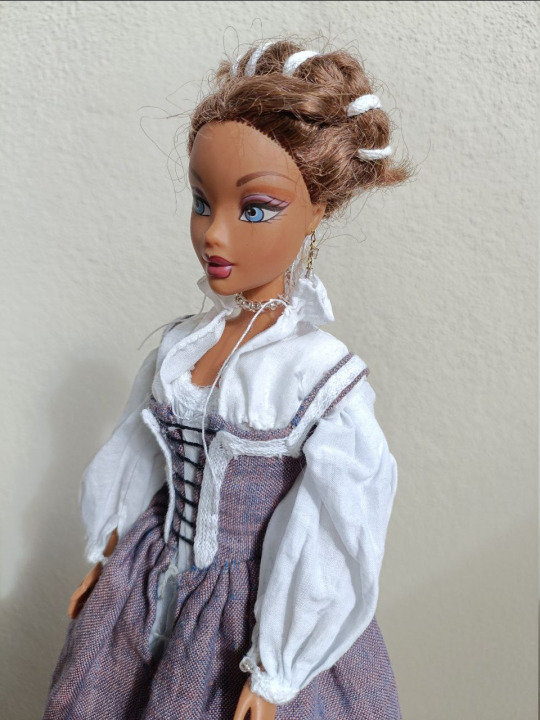
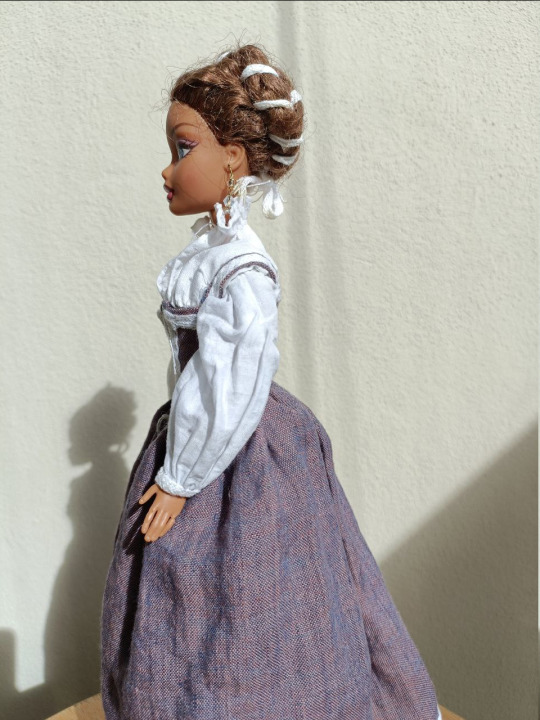
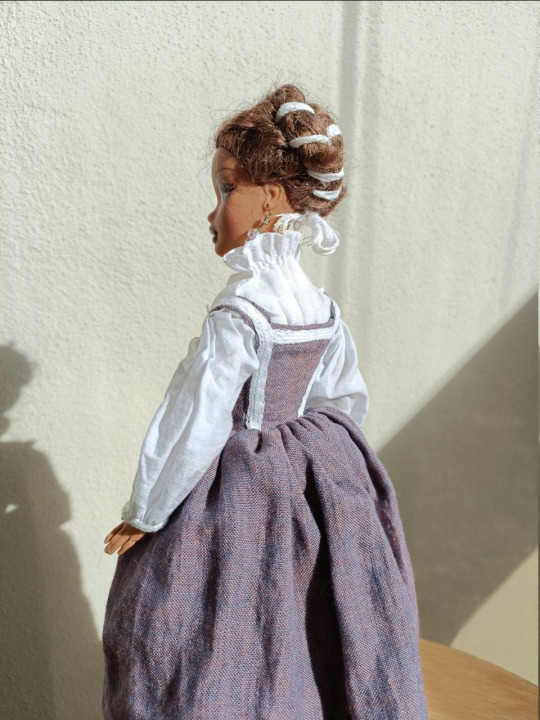
A Venetian renaissance woman of course needs her boob window partlet. Unfortunately I didn't have any super sheer linen or silk to make the fashionable sheer look.
Shoes
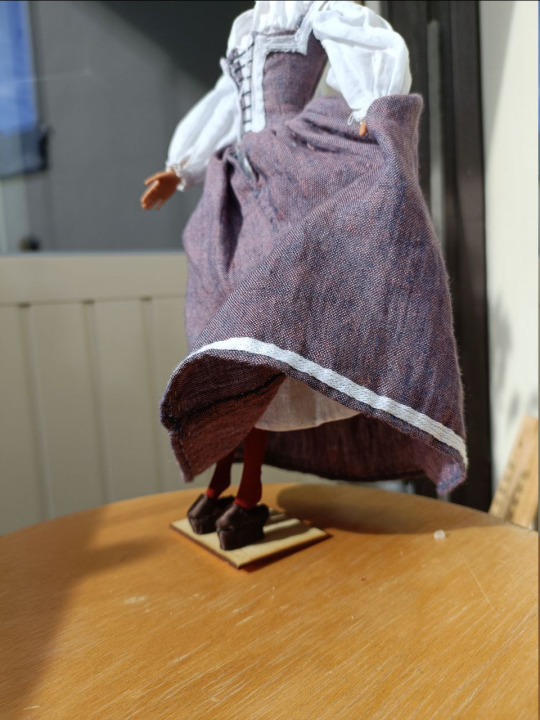
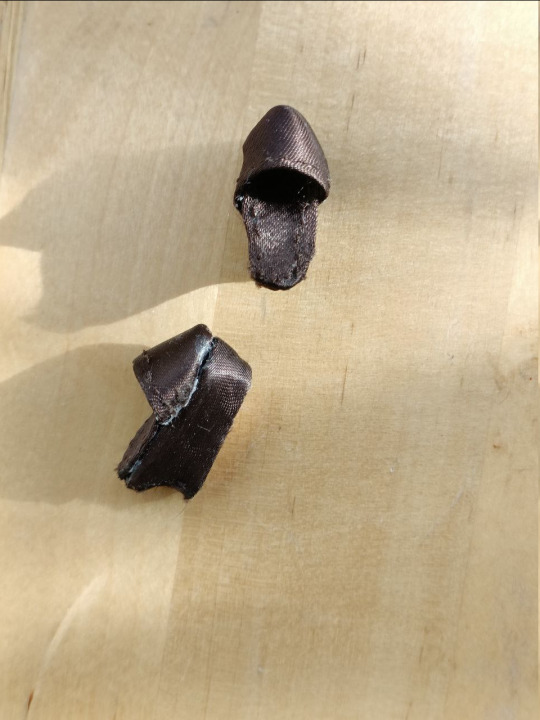
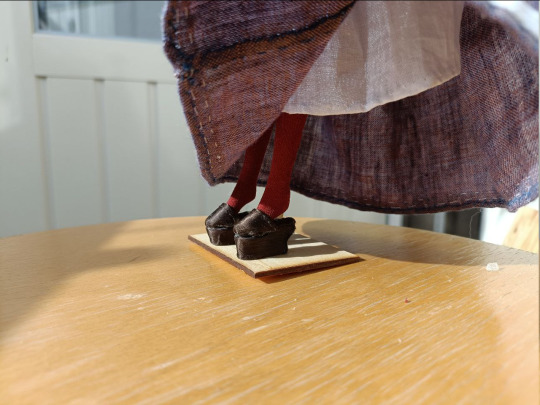
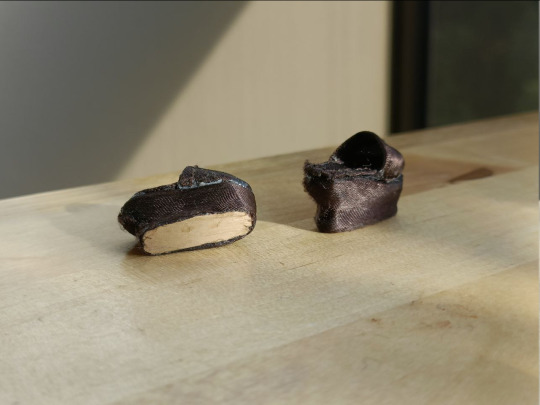
The shoes are chopines, which were very fashionable in Venice at the time. They were platform slippers with wooden base, which were covered with leather or fancy fabrics, like brocade or velvet. I didn't make the heels super tall since I was going for more toned down merchant/artisan class sort of vibe, and the very tall were used by upper class women and courtesans. I carved the heels from soft wood and covered them with sateen.
For reference here's couple of 16th century Venetian chopines.

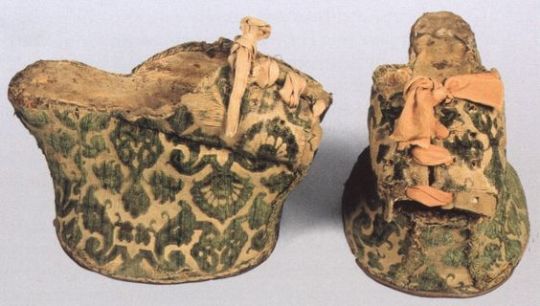
#historical fashion#fashion history#custom doll#doll customization#historical sewing#renaissance fashion#my art#historical costuming#my scene#doll#hand sewing#fashion doll#dolls
616 notes
·
View notes
Text
"He looked like a boy, masquerading as a gentleman": A meta on Amadeo, Venice, The Picture of Dorian Gray, and standing on the cusp of adulthood
TW: Discussions of SA, underage SA, human trafficking, slavery, and NSFW content
From a historical perspective, Armand's life as a teenage enslaved boy in Venice in the early 16th century gives us a chance to discuss the culture of male-male attraction in Venice during this period, specifically the contemporary understanding that older men could be attracted to young boys. This historical grounding can, in turn, offer insight into why Armand is trapped on the cusp of adulthood, how this manifests itself in his physicality, and how his story can be cautiously and sensitively used as a mirror for the real experiences of enslaved people in Venice during this period. I will be referring to him by his birth name (Arun), the name Marius gave him (Amadeo), and the name the Children of Darkness coven gave him (Armand), where appropriate.
In 1496 in Venice, illegal sexual relations between young boys and older men were so prevalent that 'special patrols [went] searching for boys who were patientes (sc. passive partners), monitoring schools for fencing, dance and song, where youths might be found in the evenings, and once again looking for companions of unequal age.'[1] This was roughly 27 years before Arun was purchased from a brothel by the vampire Marius de Romanus. Due to Armand's fractured memories of this period, it isn't clear when he was forcibly trafficked to Italy, but it is likely that he was bought by Marius in around 1523 at the age of 15 (assuming he was born in 1508, given that he says he's 514 in 2022).
As a physically attractive enslaved boy, Amadeo would have been understood as an object of desire ("object" in a literal sense, with no personhood of his own) to the older men around him. In his recent study Forbidden Desire in Early Modern Europe: Male–Male Sexual Relations, 1400–1750, historian Noel Malcolm discusses the contemporary evidence for the attraction of men towards adolescent boys. Malcolm explains that older men desiring teenage boys was a common and accepted part of Venetian culture, provided one did not act on those desires, and that attractive young men were often described similarly to women in surviving sources and contemporary literature.[2]
The important thing to note here is that teenagers were supposed to be desired before they started to show signs of maturity, when they could almost be considered sexless. As Malcolm writes, when 'a young man's looks became properly masculine (with facial hair, developed musculature, etc.), that is, fully differentiated from a feminine appearance, was precisely the time when he ceased to be seen as desirable by the great majority of older men.'[3] Due to poor nutrition, this might have occurred later for teenagers in the 16th century than it does today, but it was usually between the ages of 17 and 23.[4] Given that Amadeo was an enslaved child, and therefore probably not well-fed, he was likely late to develop. Putting aside the fact that in the books Armand is 17 when he's turned, Queen of the Damned offers some evidence for this:
'Did Daniel know that Armand had been a boy when all this had begun for him? Seventeen years old, and in those times that was young, very young. Seventeen-year-old boys in the twentieth century were virtual monsters; they had beards, hair on their chests, and yet they were children. Not then. Yet children worked as if they were men.'[5]
In light of this, it is worth mentioning that Armand has the slightest hint of facial hair. You can see this clearly in close-up shots, for instance these ones in my gifset. Here's one clear example:

With his long hair, his high cheekbones, and his thin frame, Amadeo would have fit perfectly into the feminine, feminised, youthful archetype that Malcolm describes. It would have been socially acceptable for older men to be attracted to him in Venice in the 16th century. According to Malcolm, 'When early modern writers described good-looking boys, the terms they used were drawn from a standard repertoire that existed primarily to describe female beauty: coral lips, pearly teeth, ivory skin, and so on.'[6]
Obviously, the last point doesn't apply to Amadeo. Instead, he would have been desired because he was exoticized by the Italian network of artists that Marius "donated" him to (that is to say, his Otherness would have been sexualised, as a young boy possibly from Bengal as @depressedraisin suggested here). This exoticization is apparent in how Amadeo is portrayed in The Adoration of the Shepherds — kneeling, enraptured, with a look of subservient wonder on his face. (For an incredible meta which delves more deeply into this aspect of Armand's history, I recommend reading "Armand, colonialism, and the weaponisation of anti-Blackness" by @shesnake.)
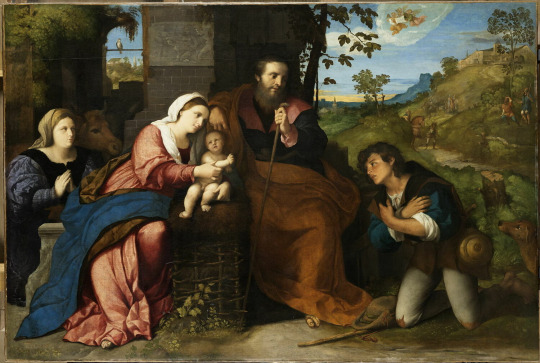
If we assume (besides his obviously lightened skin), that The Adoration is a fairly accurate portrayal of Amadeo at 20 years old, then the main difference between him at 20 and him at 27 is his slight facial hair. As discussed previously, the appearance of facial hair was a marker for young boys growing out of their desirability and into adulthood. Turned at 27, Armand is now stuck in this liminal space between boyhood and adulthood, and this is visibly apparent in his facial hair. His youth is mentioned in the show on a few occasions. When Louis first sees Armand in 2.01, he says that he 'looked like a boy, masquerading as a gentleman'. Madeline calls him 'young man' in a patronising tone in 2.06.
Interestingly, Armand's youth is mentioned more often than his race, though in the 18th-century flashback in 2.03, Nicolas asks Lestat, 'do you know this gypsy?' This is the only microaggression we've seen Armand face so far, but it offers a tiny glimpse into the kinds of comments that Armand will have faced for his entire life, both as a human and as a vampire. Obviously, Armand is not Romani, so the racial slur of "gypsy" does not apply to him (not that it applies in any context, but I mean it's literally inaccurate). However, this erasure of origins is common in contemporary historical references to people of colour. As historian Imtiaz Habib writes in Black Lives in the English Archives, 1500-1677: Imprints of the Invisible, Black people were often referenced in early modern sources using 'cryptic citations', referred to interchangeably as '"blackamore", "moor", "barberee", "barbaryen", "Ethiopian", and "Indian".'[7] Regardless of their country of origin, they were lumped together as one people.
In this way, Armand's lost origins could be seen as a representation for the surviving fragmentary evidence for people of colour from across the globe in English archival sources. He himself describes his memories in 2.04 as "fragments". This may be read as a metaphor for the sparse and fragmentary surviving archival evidence for enslaved people's experiences in the early 16th century, especially enslaved children. Where the evidence does survive, it is limited, and enslaved people's stories are usually recounted through the lenses of their white owners or observers, with their own voices lost to history.
There is another aspect of Armand's life which may be mirrored with the life of a real specific enslaved person. In Contested Subjecthood: Runaway Slaves in Early Modern Venice, historian E. Natalie Rothman recounts the story of Omar, an enslaved boy from Zara, living in 17th century Venice, who was given the name Pierantonio by his enslaver.[8] He had a long history of service since childhood, and had been baptised in 1648 when he was 10 years old, and, at the age of 32, was seeking permission to be married. Rothman writes that Omar's story:
'suggests ways in which enslavement as a child could actually facilitate effective forms of social, as well as spatial mobility, while curtailing others. His long years of service as a baptized slave were eventually rewarded by formal manumission [release from slavery], the acquisition of a trade, and insertion into a network of patronage that secured his ability to forge new kinship ties in Venice.'[9]
Likewise, it was Amadeo's long and loyal service to Marius, since childhood, which ultimately allowed him to become a vampire ('facilitate effective forms of social, as well as spatial mobility'). If Amadeo had not been Marius' property for as long as he was, if he had not had "skill", as he puts it, then Marius would not have shared the Dark Gift with him. It might be a slightly clumsy comparison, but vampirism could be seen as what Rothman describes — the reward of a trade and new kinship ties. However, though he had been rewarded, Amadeo was not yet freed from his service to Marius. He was now frozen in that place between boyhood and adulthood, having not quite lost what made him special to Marius, but not being the same boy he was.
Finally, this liminal state is manifested not only in his slight facial hair, his long hair, and his youthful features, but it is also realised in The Adoration. I made a gifset overlaying a quote from The Picture of Dorian Gray by Oscar Wilde with scenes of Armand looking at his portrait, which is relevant in this discussion. Armand is almost Dorian Gray in reverse. He might have lived for five centuries, but he a part of his soul is still trapped in that portrait, in a position of unwilling subservience. The fate Dorian Gray laments has happened to Armand. He has grown older, and taken on the countless sins of his vampiric life, but his picture has remained the same — frozen in servitude, representing that young boy who was adored for his beauty.
Bibliography
1. Noel Malcolm, Forbidden Desire in Early Modern Europe: Male–Male Sexual Relations, 1400–1750 (University of Oxford, 2024) p. 44. 2. Ibid., pp. 179-81. 3. Ibid., p. 180. 4. Ibid., pp. 46-7. 5. Anne Rice, Queen of the Damned (Warner Books, 1996) p. 102. 6. Malcolm, Forbidden Desire, p. 179. 7. Imtiaz Habib, Black Lives in the English Archives, 1500-1677: Imprints of the Invisible (Taylor & Francis Group, 2007) p. 2. 8. E. Natalie Rothman, Contested Subjecthood: Runaway Slaves in Early Modern Venice, Quaderni storici, NUOVA SERIE, Vol. 47, No. 140 (2), Riscatto, scambio, fuga (AGOSTO 2012), pp. 425-6. 9. Ibid., pp. 426-7.
#iwtv#iwtv meta#interview with the vampire#interview with the vampire meta#armand#the vampire armand#sophie speaks#sophie metas#sophie talks about iwtv
191 notes
·
View notes
Text


1600s WOMEN - PART 3
A quirky little trend that was popular in the 1600s was the fashionable wearing of masks. These were usually made from pasteboard or leather and covered in black silk or velvet, making them a relatively affordable and highly visible way of wearing fine fabrics without having to purchase the yards of textile required for a full garment. They also provided privacy and an air of mystery to the wearer. CC links and reference images under the cut.
You can find more of my historical content here:
1300s ✺ 1400s ✺ 1500s ✺ 1600s ✺ 1700s
1 - Lace Mask by Altea127 (TSR)
2 - Mask N2 by S-Club (TSR)
3 - Harley Quinn Mask by Plazasims
4 - Bandit Mask by Suzue (TSR)
5 - Venetian Mask by Bokchoijo
6 - Vittoria Mask by Blue Craving
7 - Mascherare Scaramuccia Mask by Javi Trulove Sims
8 - Harley Quinn Mask by Plazasims
9 - Showtime Mask by Blueberry (Curseforge)
10 - Flavio Mask by Blue Craving
11 - Doge Mask by Blue Craving
12 - Colombina Mask by Blue Craving
With thanks to some amazing creators: @plazasims @bokchoijo @bluecravingcc @javitrulovesims
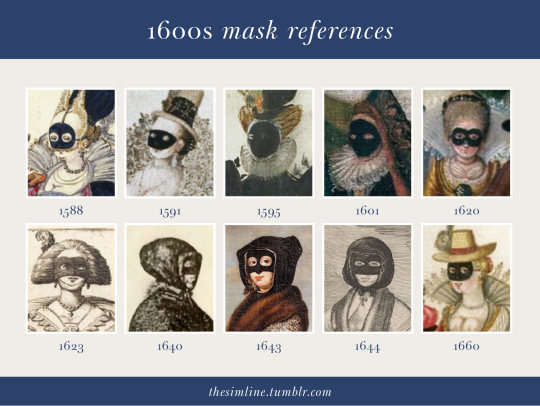
#1600s#baroque#ultimate decades challenge#ts4 decades challenge#ts4 historical#ts4#ts4 cc cas#the sims 4#sims 4 decades challenge#ts4 history challenge#sims 4 history challenge#sims 4 historical#historical cc#17th century#ts4 cc#the sims#s4 cas
229 notes
·
View notes
Note
Hi :3
Regarding your post on transmasculine cross dressing and prostitution, do you have anymore sources on specifically the Italian instances?
Also I'd love to hear more of your thoughts on it, both in general or in any specific part :3
Here's the source the paper cites (Venice: A Documentary History 1450-1630):
Sexual dissimulation condemned, 1480 From the Latin. Decree of the Council of Ten, 15 March 1480 The coiffure [habitus capitis] which Venetian women have recently taken to wearing could not be more indecent in the sight of God and men, since by means of this coiffure women conceal their sex and strive to please men by pretending to be men, which is a form of sodomy; and therefore be it determined that by the authority of this Council the Heads of the Ten or at least two of them shall go to our Lord Patriarch and persuade him, by means of the confessors and also through an edict to be published in all the parishes, to prohibit the hairstyle [gestamen capillorum] which women adopt, and which they call a 'mushroom' [fungus], and which hides the forehead; and to order the hair to be drawn and tied back behind the head, and the forehead and face to be made free of it, that they may be seen as women, just as God made them, and as was their custom before the presented corrupted age: all of this upon pain of excommunication.
Also the art of a cross-dressing sex worker used in the paper:

Unfortunately, but not surprisingly, I haven't been able to find anything else discussing this.
Its honestly wild to me that in all the discussions of transness and sex work, even specifically historical sex work, I haven't heard anything about this. People seem so uncurious about transmasc history? Its the same thing with the pilipili of Inanna. Like, I've heard so much about the gala as the transfem priestesses of Inanna, but I can barely find anything on the pilipili.
I just wish people would be more self-critical about the absence of both information on transmasculinity, and the lack of interest in analyzing things from that perspective. Stop viewing transmasc absence as natural! People need to start feeling the hole where transmasc stories should be in our cultural and realize how purposeful this exclusion is.
203 notes
·
View notes
Note
I figure you might know this: is there any connection between historic poisonous makeup / skin cream, and the tendency of modern skin whitening creams to have high heavy metal levels? Like, one paper suggested that the high mercury levels of black US women are explicable by (illegally imported) creams and not e.g. pollution. Does mercury/ lead / arsenic actually improve skin somehow, or is it a contaminant, or what?!
Yikes! I always feel awful for people who are subject to those pressures- for light-skinned women, we're told to set ourselves up for cancer by tanning, and dark-skinned women are pressed to use poisonous bleaching creams. It's not the SAME pressure, since one has the weight of systemic racism behind it, of course. I just find it interesting (in a sad way) that no matter what skin tone you have, someone wants you to harm yourself to change it.
That said, I don't know much about skin-bleaching agents in the past (besides lemon juice for getting rid of freckles, which is a great way to badly sunburn yourself). Venetian ceruse and other white lead "foundations" were basically just a translucent white paint, not a skin product. The lead was only to get the white color. They were also not as commonly used- at least in the 16th century and later -as people often think today. The dangers were pretty well-known, if not fully understood, to the point where the 1760 death of unpopular socialite Maria Gunning was blamed on white lead makeup. A story which is still widely believed, even though I found no solid evidence for it being anything but slander.
The arsenic thing came from an 1851 scientific paper by Johann Jakob von Tschudi, in which he described Alpine peasants slowly acclimating themselves to larger and larger doses of arsenic over years. He speculated that the lovely complexions of women and girls in these villages might be due to arsenic-eating, though by what mechanism is unclear- long-term arsenic exposure actually darkens the skin, something Europeans at the time would not have held in high regard. Still, the beauty industry picked this up and unscrupulous companies began selling arsenic "complexion wafers," which made pretty much every skincare claim under the sun: they were good for acne, freckles, redness, roughness, oily skin, wrinkles...you name it. Of course, the fact that these companies were so unscrupulous probably saved women who believed the claims of "safe dosage" on the packaging- an 1893 study of one popular brand, in the Boston Journal of Health, found that the wafers contained nearly undetectable amounts of arsenic or none at all. That's just one brand, but it's not hard to imagine others doing likewise.
I know less about mercury in skincare/beauty products because you don't hear about it as much, but I did find evidence that it's been used in bleaching creams as far back as the early 20th century (again, targeting mostly women of color). Also that the use of cinnabar in some rouge preparations, in ancient Rome and Iberia, may have caused some mercury poisoning.
So yeah. Less related to the lead and arsenic history, but it seems mercury bleaching creams have at least a 100-year legacy. Horrifying.
39 notes
·
View notes
Text
( CW: blood )
Belladonna of madness, My fair lady of sadness, I had wondered sometime If your kiss would taste ripe. Now it’s sweet on my tongue When my hour is sung.🫐
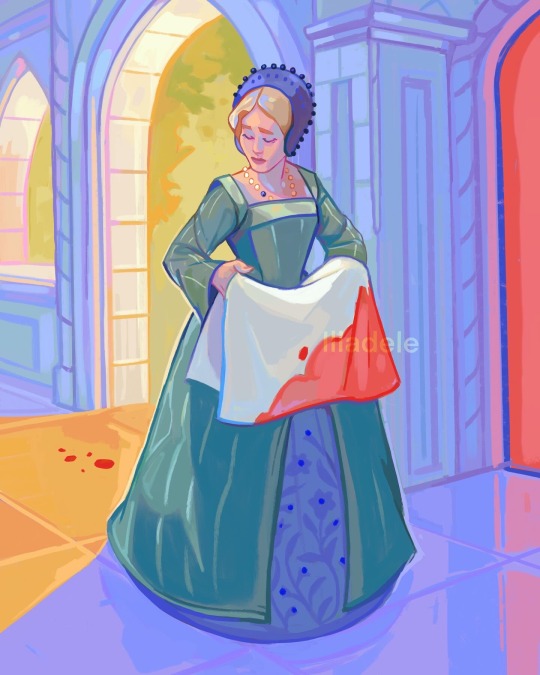
A piece about belladonna’s poisonous berry. I am thinking a lot about the idea that has historically equaled poisons to “a woman’s weapon”. What have poisons meant for women in history? I think about how we are so ready to ingest daily poisonous words, so much that maybe we are desensitised to most. Anyway, I am reflecting a lot about these topics, but I have yet to form a coherent poetic argument on it. Did you know that the flower is called “Bella Donna”, meaning, beautiful woman, because ladies in the Venetian court used small amounts in eye drops to make their pupils dilate and look more “attractive”? Really makes you think, uh. I had missed writing little rhymes for art
66 notes
·
View notes
Text
Brazil 🇧🇷

Tradition
Carnaval is a wild celebration of food, alcohol, music and fun. It's held annually for a few days before the start of Lent, the 40-day period of fasting, abstinence and repentance that's observed by the Roman Catholic Church before Easter. The word carnival comes from the Latin carne vale, or "farewell to the flesh"
The Portuguese brought the practice of Carnival to Brazil around 1850, patterning it mainly on the Parisian tradition of holding masquerade parties and balls at this time of the year. However, the Brazilians morphed it into a version uniquely their own over time, adding in elements from the people's African and indigenous cultural backgrounds.

Thus, Carnival in Brazil eventually incorporated lots of parades, elaborate costumes, music, dancing and balls. A tradition also developed where people dress up in opposing roles: men dress as women, aristocrats dress as commoners, the poor dress as the rich.
Carnival is held all over the country; celebrations differ a bit by region, but Rio de Janeiro's celebration is the most popular, drawing crowds of 500,000 foreigners annually from across the globe.
While all Brazilians love Carnival, the black communities are its most avid participants. This likely stems from the community's historical love of Carnival, as African slaves were freed annually for the festival's duration.
Traditional outfits

People wear the same types of clothes in many places of the world. Jeans and T-shirts are worn in most countries, replacing traditional garments. But for special occasions or celebrations, some people choose to bring back the memories of the past by wearing a traditional costume. While they don't wear it every day, Brazilians care about their traditional clothing and wear it for different occasions, such as carnivals or national celebrations.
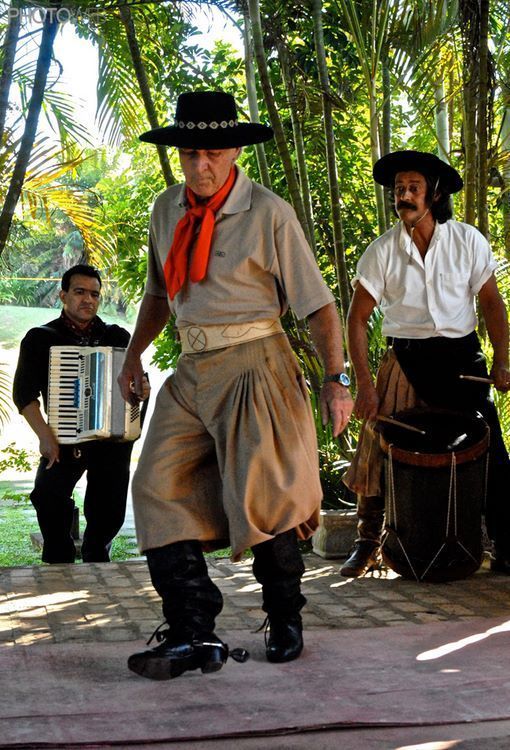
In general, Brazilians wear clothing that's comfortable yet richly colored and sophisticated. However, there are some preferred clothing types depending on region.
For example, those living in the southern plains, a ranching area, wear gaucho-type clothing: baggy pants, or bombachas; cowboy hats and cowboy boots.


People in the country's northeastern Bahia region, which is heavily influenced by African culture, don long skirts, head scarves and shawls. Items adorned with bordado richelieu -- a type of lace developed in 18th-century France to mimic white Venetian lace, which was brought to Brazil by the Portuguese -- are also popular
Another way to consider Brazilian clothing is country attire versus city attire. Those who live in the country tend to wear shirts, jeans or dresses crafted from an inexpensive cotton material. Women who reside in the city often like to wear short skirts and dresses, and both sexes of city slickers enjoy that most typical of Western attire: T-shirts and jeans.
Statue of Christ the Redeemer.


Towering 2,310 feet above the city of Rio, the Christ the Redeemer statue has fascinated experts and historians for nearly a hundred years.
This landmark is must-see in any visit or free tour around Rio, and for good reasons! It’s the fourth largest statue of Jesus Christ in the world, the largest Art Deco-style sculpture on the planet, and to top it all off, in 2007 the statue was deemed as one of the New Seven Wonders of the World along with Machu Picchu, the Great Wall of China and the Roman Colosseum.
Perched on the summit of Mount Corcovado in Rio, the statue stands at a whopping 98 feet (or 30 metres) tall (making it two-thirds the height of New York’s Statue of Liberty), and its outstretched arms reach to 92 feet (or 28 metres) horizontally.
The idea of designing a massive statue of Jesus Christ in Rio first came about way back in the 1850s, when a local priest came up with the idea of placing a Christian monument on top of Mount Corcovado. Apparently he had requested Princess Isabel (the daughter of Emperor Pedro II and Princess Regent of Brazil at the time), to fund the project, but the idea was scrapped after a Declaration of the Republic was declared in Brazil in 1889 – a pinnacle move as it separated the church from the state in the country.
Traditional food

Feijoada.- Brazilian Feijoada is a black bean and pork stew that Brazilians often serve topped with farofa, toasted cassava flour. Many call this comfort food the national dish of Brazil.
Feijoada, a popular Brazilian dish, owes its name to its main ingredient, black beans (feijão). It is a rich stew traditionally made from different parts of the pig, such as feet, ears, and bacon, as well as other smoked meats.

Farofa.- farofa is particularly popular, typical recipes call for raw cassava flour to be toasted with abundant butter, vegetable oil or olive oil, salt, bacon, onions, garlic, sausage, or olives until golden brown.
Farofa is served alongside the main course and can either be sprinkled on by individual diners to their taste before eating, or eaten as an accompaniment in its own right, as rice is often consumed

Moqueca de Camarão.- Brazilian prawn coconut stew (moqueca de camarao) is an easy and delicious low-carb recipe that features a unique combination of spices.
As with many recipes of this kind, you'll find lots of variations for moqueca de camarao, but all of them are loaded with prawns, tomatoes, chillies, garlic, coconut milk, and lime juice.
Vatapá- Brazilian dish made from bread, shrimp, coconut milk, finely ground peanuts and palm oil mashed into a creamy paste. It is a typical food of Salvador, Bahia and it is also common to the North and Northeast regions of Brazil
Acarajé-The crispy bean and onion cakes (acarajé) are stuffed with a flavourful vatapá - a popular Brazillian mix of shrimp, crab, nuts and coconut milk.
Dixon, R. (2018). What Are Some Traditional Clothes Brazilians Wear? | Synonym. [online] Synonym.com. Available at: https://classroom.synonym.com/what-are-some-traditional-clothes-brazilians-wear-12079370.html.
[email protected] (2023). The Story Behind Rio’s Christ the Redeemer Statue | Strawberry Tours. [online] ONEPORT. Available at: https://strawberrytours.com/the-story-behind-rio-s-christ-the-redeemer-statue.
3 notes
·
View notes
Text
Powerful women from the classical world + excerpt of a letter from Lord Byron to Thomas Moore describing his lover Margarita Cogni (Venice, September 19th, 1818):
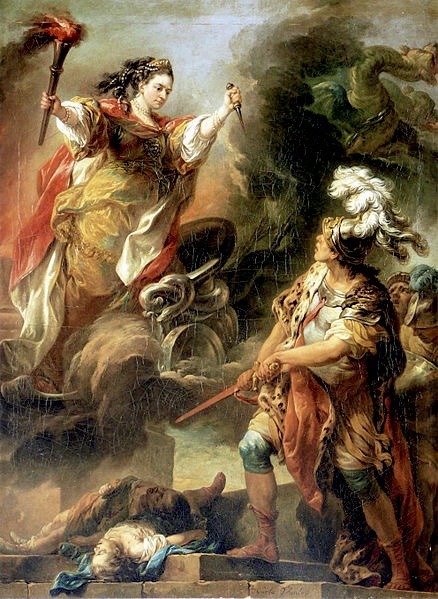
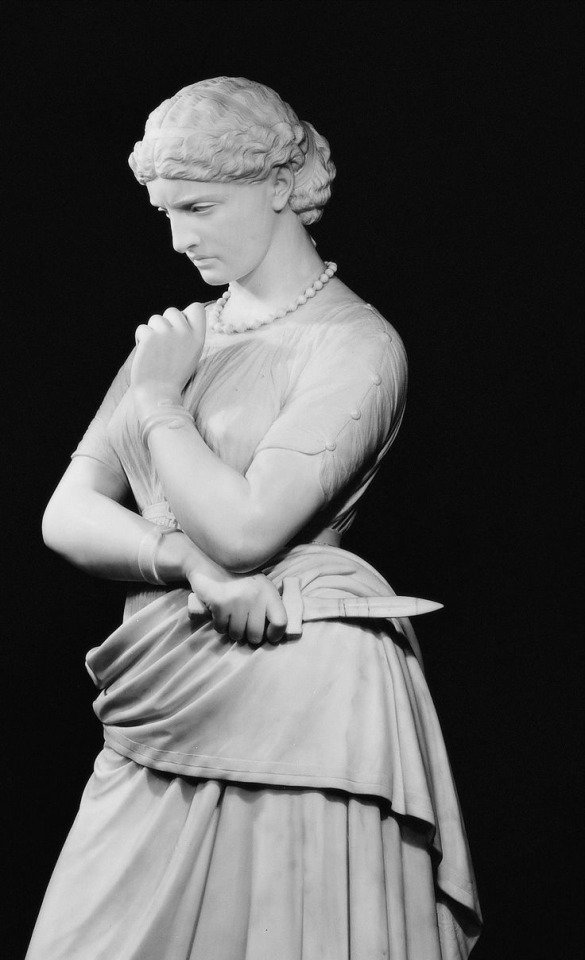
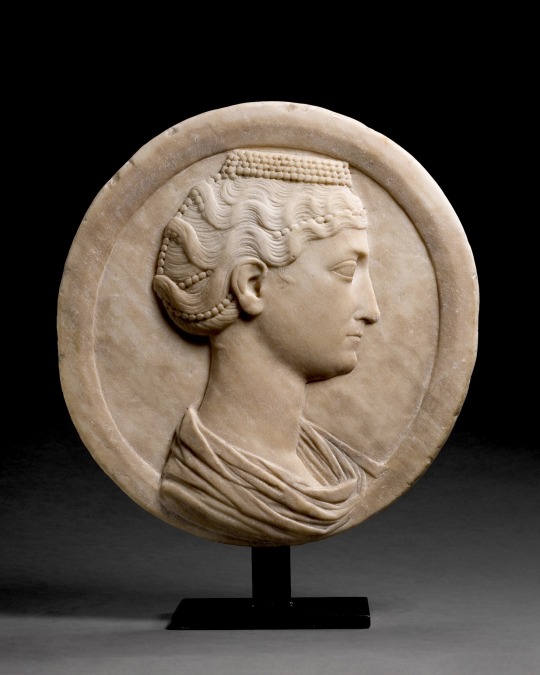



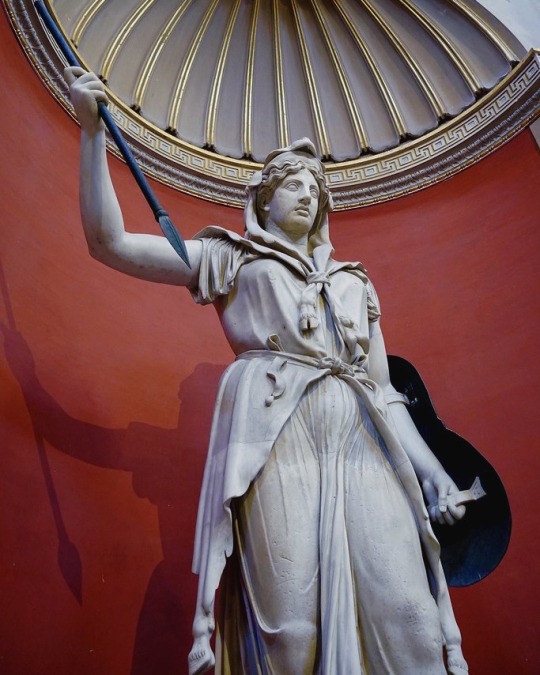
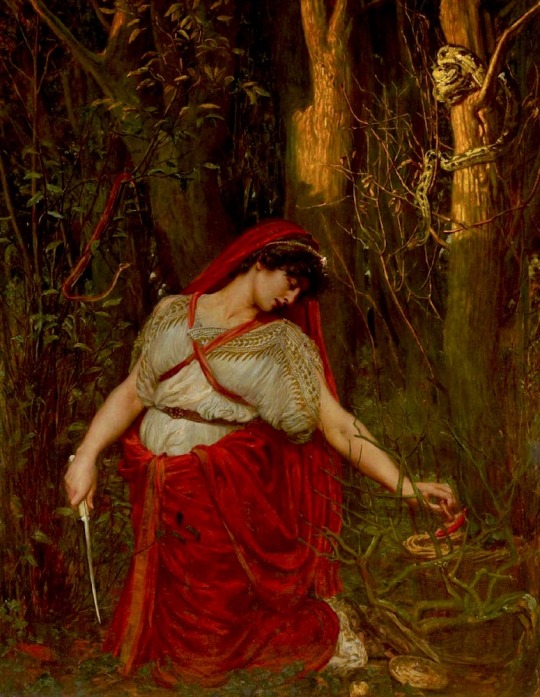
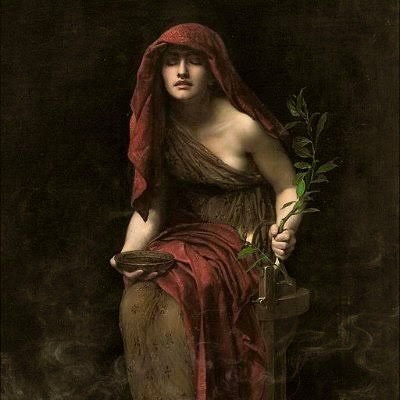
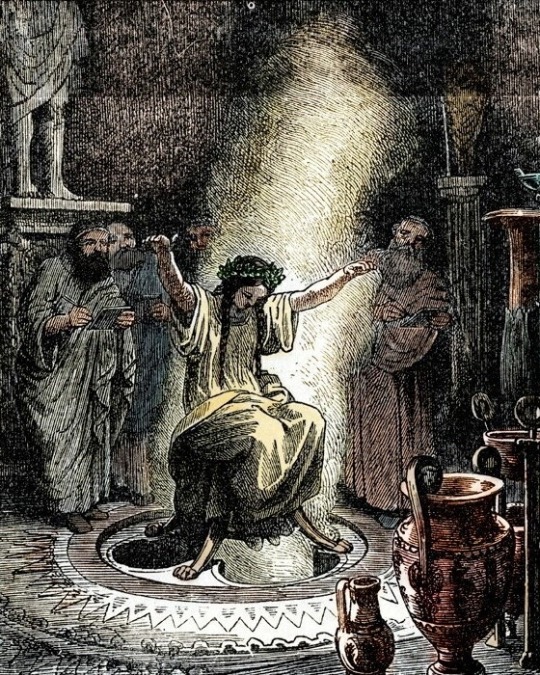
“I wish you a good night, with a Venetian benediction, ‘Benedetto te, e la terra che ti fara!’ — ‘May you be blessed, and the earth which you will make!’ — is it not pretty? You would think it still prettier if you had heard it, as I did two hours ago, from the lips of a Venetian girl, with large black eyes, a face like Faustina’s, and the figure of a Juno — tall and energetic as a Pythoness, with eyes flashing, and her dark hair streaming in the moonlight — one of those women who may be made any thing. I am sure if I put a poniard into the hand of this one, she would plunge it where I told her, — and into me, if I offended her. I like this kind of animal, and am sure that I should have preferred Medea to any woman that ever breathed.”
The mythical and historical allusions:
In Roman myth, Juno was Queen of the Gods as well as a military figure often depicted armed. In Greek myth, Medea was a sorceress who gets revenge against her unfaithful husband through murdering their children and his lover. Although “Pythoness” could refer to demonic witches in other uses, Byron is using it here as another name for Pythia or the Oracle of Delphi, a divine priestess and the most powerful female office in the ancient world.
Faustina is either a reference to the Younger or the Elder. Faustina the Younger was the wife of Marcus Aurelius; he revered her so much that he gave her enormous power, although later historians (probably falsely) accused her of being a murderer and adulteress. Faustina the Elder was the adoptive mother of Marcus Aurelius and was one of the most beloved Roman women in history, whose coinage often features Juno.
Byron's life and writing in context:
When he was living abroad in self-exile, Byron often sought to entertain his friends back home by sharing his adventures in lurid detail. His vivid letters became well-read throughout the 1800s, and are considered some of his best writing. Travel writing and adventure stories were extremely popular in the 19th century, and even most of Byron’s fiction champions these themes. Living abroad and traveling became marketable parts of Byron's celebrity. He blended his own experiences into his work, and chief among these were his romantic experiences.
Shelley once compared Byron to the Greek myth of Circe when writing in a letter about Byron's excessive amount of pets. Circe was known for seducing men and turning them into animals who roamed around her palace. Like a witch or an alchemist, Byron frequently transformed his lovers into characters through his writing. Like countless others, Margarita Cogni was mythically immortalized through the writer's description of her. She and Byron's other Venetian lovers have become part of the wider Romantic era mythology tradition, like the constantly retold tales of Mary Shelley's invention of Frankenstein, Percy Shelley's drowning, and John Keats' love for Fanny Brawne.
By using references to classical women in this letter Byron is not only paying tribute to mythology, history, and the Italian landscape in a way that his foreign audience would find tantalizing, but he is also exploring romanticized notions of classical female beauty which are at turns conventional and unconventional. He channels the gothic sublime through the otherworldly power and danger these women all represent, as well as channeling more traditional concepts of feminine strength rooted in modesty, beauty, and passivity. Byron creates poetic contradictions.
Just as he famously describes himself as “changeable, being everything by turns and nothing long,” he utilizes paradox and inconstance in his writing, such as in this satirical formulation of Margarita Cogni as the ideal lover who is both Goddess and woman, mistress and slave, contemporary and classical, masculine and feminine, wife and adulteress, murderess and murdered.
One can clearly see how this is the same chameolonic, binary-blurring poet who would go on to write the gender-bending themes of Don Juan — “If people contradict themselves, can I / Help contradicting them, and every body, / Even my veracious self?” — and who years beforehand had written She Walks in Beauty — where “all that’s best of dark and bright / Meet in her aspect and her eyes.”
#literature#english literature#lord byron#romanticism#poetry#dark academia#aesthetic#history#mythology#analysis#my analysis#my writing#my essays#byron#poems#letters#women#art#myth#greek#roman#british#english#academia#the romantics#love#romance
70 notes
·
View notes
Note
19 + 28?
Thanks for the asks! ^^
19. Favourite historical book?
Definitely The Great Cat Massacre by Robert Darnton, more on that here!
But to mention another one, I really like Carlo Ginzburg's The Night Battles. It's wonderfully weird and I really like the fact that the author clearly has a lot of empathy for the subjects which he's writing about (16th/17th century Venetian villagers accused of witchcraft. They rarely make sense but their heart seems to be in the right place. Usually.)
Also, not sure if it's a historical book per se or if it counts more as a philosophical one, but I've recently read the Selected Philosophical and Scientific Writings of Émilie du Châtelet and it's really, really good. It includes a preface about the changing role of women throughout history (confirming, among other things, my long-held opinion that I was right to prefer Plato to Aristotle and my belief that I would have killed it in a medieval convent), her brief biography, some absolute gems of her letters and a lot of her writing!
28. Favourite “dream team” of specific era or the entire history?
Woah, that's a tough one! I love the triumvirates from Roman history (Caesar/Pompey/Crassus? Mark Antony/Octavian/Lepidus Fulvia? I mean hello?), but those were more of a nightmare team than a dream team to be completely fair.
So maybe I'll go with the Encyclopédistes. I have a soft spot for Diderot. Voltaire and Rousseau bring the drama (apparently, the section about Geneva was a sneaky roast of R? I approve wholeheartedly!) d'Alambert seems reasonable, but he's caught in the crossfire. Plus, Émilie should totally be seen as a part of the dream team, since they apparently used a her work and just didn't credit her.
#ask game#ask away!#ask tag#history#roman history#ancient rome#roman republic#historiography#age of enlightenment#enlightenment#philosophy#french history#émilie du châtelet#voltaire#jean jacques rousseau#denis diderot#encyclopedia#18th century#mark antony#julius caesar#fulvia#octavian#crassus
4 notes
·
View notes
Text
Writer Introduction
Greetings, fellow writers of Tumblr! I thought I should introduce myself, as I have been lurking quietly for a while now, and you all seem like excellent writers with interesting projects.
About Me
I’m a teenage English girl, with a passion for history, literature, the odd cosplay, and storytelling. I’ve been making up roleplays with myself since I was small, and my stories have always kept me company.
I’ve grown up reading Shakespeare since I was seven, as well as the more traditional children’s classics, and have since found that my passions lie in fantasy worlds, historical fiction, and detective fiction/murder mysteries, although I like to dabble in all genres if I get the chance.
My WIPs
I am currently in the middle of writing two novels, a short story that has accidentally turned into a novella, and various short stories, flashfiction and any other bits and pieces that take my fancy.
The Jack of Diamonds
This is a historical fiction set in 1890s London, and focuses on the criminal classes, and the anonymity of personal and public life that is so prevalent across Late-Victorian Literature.
The plot centres around a young Aristocrat called Philip Devlin, and the double life he leads as London’s most infamous criminal. It’s still very much half formed, so I can’t be amazingly accurate about everything that’s in it, but it might be your cup of tea if you like:
Close Male Friendships that fall apart unexpectedly.
A strong female character who doesn’t fall in love with the protagonist.
The adventure/mystery style of Conan Doyle and Maurice LeBlanc.
And the inevitable morally grey Venetian of all good stories.
Echoes of Eternity (Working title)
This is a fantasy/folklore work, centred around the Arthurian legends, and has a time travel/time slip element to it. There is also an exploration of power and the damage it causes, as well as how death affects the living.
This is still mostly at a world-building stage, although I have written the odd scene out, so the plot is still fairly nebulous, but it follows the dual paths of a young mage called Amser from Arthurian times, and the story of Rose and Jay Fleetwood, as they attempt to right the wrongs of the past together. This might be up your street if you like:
A Morally Grey protagonist with dubious motives.
The magic of King Arthur and his knights.
Magic systems similar to those used in The Secrets of the Immortal Nicholas Flamel series by Michael Scott.
And randomly angry ghosts leading to time travelling quests
A Monstrous Regiment of Women
This is historical fiction meets fanfiction, with a good helping of biographical info thrown in. It’s set during the Napoleonic Wars, and examines the place of women in that society, the psychological effects of war, and how the Napoleonic Wars shaped Europe.
I Have reimagined Napoleon Bonaparte and the Duke of Wellington as women, Letizia Bonaparte and Francis Wellesley respectively, and have imagined how their lives would look if they had still enlisted in the military. This is probably the most complete of my major WIPs, as all the information and plot is already available in history books, I just need to jig it around. You might like this if you enjoy:
Stories with good depictions of battles in them.
Regency Literature, or pastiches like Johnathan Strange and Mr Norrell by Susanna Clarke.
Strong female protagonists acting outside societal norms.
Sweeping story arcs that cover a character in a range of situations and moods.
Other Bits and Pieces
I often write short stories, and most of them end up on my AO3 account. It’s a rather eclectic mix, with a lot of crossovers, but I enjoy writing them a lot. You can find it below:
I am more than up for being sent asks, participating in tag games etc, and love writing socially. I’m also happy to share any tips or prompts I think up, although those will be very sporadic given all my writing to date has been mostly self-governed. Generally speaking I’m somewhat uncomfortable with NSFW type prompts, asks etc, so avoid those if possible.
Finally, I look forward to chatting to you all and sharing my creations. Happy writing everyone!
#writeblr#writers on tumblr#creative writing#writers intro#ao3 writer#fantasy writing#historical fiction#mystery fiction#new writers on tumblr#new blog#writer info#my wips
15 notes
·
View notes
Text

writer muses + publications: Claude di Montoya (1816-1910) long post under cut. consider reading on blog instead.
Initially wrote absolutely repugnant stage plays and operettas for their friend Armand's theater, each one rebuffed for their lack of quality. That was in the 1830s.
By the 1850s, Claude was publishing parables and parallels about their own life with a marked rise in quality. Certain plays have survived into the modern era, regarded as Re-Unification era classics in their native Italy. They also put their memoirs to paper, and enterprising historians have published both their private correspondences as well as biographies.
Of their works, ten are extant and still either studied or performed to this day. However, private correspondence from the Marquis implies that there are at least a handful of post-1870 plays that existed and were subsequently lost. The general consensus among historians and fans are that Claude's writings were condemned and these last five works subsequently lost in the face of the second World War, or that the Church censured the missing works shortly after Claude's demise.
The Violin: A Fantasy of the French Stage (1847): A more down to earth theatrical adaption of the recollections of their companion/lover Armand about the events of the 18th century theater scene. It is about the violinist Nicolas and his mastery of the eponymous instrument, which was the source of his genius and his sorrows. A tragedy in several parts, renowned for its 'Seraphim' monologue before the protagonists true downfall.
Ali and Vasiliki (1849): A play concerning the love affair between Claude's in-laws, meant to be a more realistic approach to the infamous Pasha and his Christian wife. each act presents a different period in their life together, culminating in the death of Ali and enslavement of Vasiliki. Was not well-received at the time due to presenting a more fair and balanced portrayal of the despot in question, but has since been re-examined as a fine enough piece of historical drama written by someone with actual facts ad a tie to the narrative itself. Written on the occasion of their ten year anniversary to Haydee.
The War of Hearts (1850): A historical dramedy that is gay as all Hell. Focuses on the budding dynamic between the Ottoman spy Esra and the Venetian concubine Amanda during the Ottoman-Venetian Wars. Perhaps the bawdiest Claude has ever been. It drips with sapphic tension and cuckoldry of fumbling older men who have no business with young ladies. The protagonists are thinly veiled pastiches of Claude and Armand but as cis women. Considered outrageous at the time but has entered Actually Pretty Funny reception in the modern era and coming out of a spate of censorship to great acclaim with the queer community.
Zlata: A Slavic Romance (1854): A romance in the classical adventuring sense of the era. The story of a dashing soldier and his love for a girl back home who endures comedic tribulation and shifting fortunes in his absence. Finale involves the eponymous lady love, now a robber queen, testing the fidelity of her now wealthy lover, a test which he of course passes so there are happy endings all around. Initially a biting satire of the wheel of fortune that was endemic to Claude's society, it's largely lost this satirical element and been played as a straight adventure. Has been adapted for film.
The Artist (1855): Written on the death of Queen Adelaide, this is a scathing condemnation the gall of King Victor Emmanuel to immediately raise his mistress to power. The problem Claude has is clearly not that Rosa have been given such power, but that the King was two-timing his wife and the affair in question began when Rosa was only a teenager and the King nearly thirty. Maybe it's also a 'fuck you' to their bestie/lover's Maker. It's a blur. Claude basically wrote 'as killing the wolf protects the farm, predators should not be mistaken for human, so hunt them freely, daughters of Italy.' Yes, they still had to work with Victor Emmanuel after this, and yes, it was awkward.
Citizen Robespierre (1858): Written on the occasion of his 100th birthday, Claude basically spends pages upon pages making Maximilien Robespierre out to be a poor meow meow and unsung hero of liberty. It's nothing but a plea for the audience to hear Claude out about how wonderful the man was. Haydee walks in at midnight and finds them sobbing at their writing desk because they're trying to play defense attorney to a dead Revolutionary several generations after the fact. Only really known about among the FreRev fandom crowds.
General Dumas (1862): Written on the occasion of his 100th birthday, Claude basically spends pages upon pages making Thomas-Alexandre Dumas out to be the utter chad he was in life. It's nothing but unadulterated fanboy'ing on the part of Claude. They black out and wake up with an entire play written about just how cool this man was. For some reason (racism/attempts to obscure Dumas' prestige) has been largely forgotten among their works.
At the Evening's Show (1868): Written for the 30th anniversary of their insufferable friendship with Armand. A meta satire about the Vampires of Paris getting ready for a show where they pretend to be humans pretending to be vampires. Several layers deep irony and some pretty heavy slapstick that was written in the hopes of killing Santino in an on-set accident. The thing was written specifically to stress out/pigeonhole the troupe in question. It's only remembered in the modern leg of their mainverse because it proves that the Théâtre des Vampires was real and woven into the narrative of the allegedly fictional bestseller Int*rview With a Vampire.
Love of the Damned (1869): Claude taking potshots at the Catholic Church in the calm before Rome's fall. An eerily predictive approach to the corruptions and abuses of the Church that was the final nail in the coffin of the Church's goodwill towards them. Modern historians attribute a lot of the vitriol found within to their growing up as the neglected child of a lustful priest. Modern audiences are often unsettled by how much of their accusations against Rome still hold true.
The Memoirs of Claude di Montoya, Marquis of Cea: Being the Reflections of a Venerable Revolutionary at the Birth of a New Century (1900): Claude's memoirs, tastefully sanitized by the Italian regime. Basically plays a rousing game of chicken about their own identity and sexuality that was pushing it in the 20th century and is widely regarded as the closest they could come to being 'out' by modern historians.
8 notes
·
View notes
Note
what's the deal with alison weir? that last example you posted, with jane and henry, you can't say is a mistake, wrong translation, whatever, it's a blatant lie. why? what is her motivation? what does she get out of not telling the truth? and, more important, why has her version been so welcomed and accepted by the media and wider culture? is she just telling people what they want to hear? why even when dozens of qualified historians disagree with her, with evidence, is she still seen a trusted source?
The odd thing is that she does include what is probably the most damning contradiction to that statement, but characterizes it as evidence of Henry being 'protective of her'...? Also not for nothing but the first part of this excerpt negates its conclusion:
Her daring plea to Henry to save the monasteries speaks volumes for her moral courage, for it was made at a time when the Pilgrimage of Grace was on the march, and effectively she was siding with the rebels who were opposing the King’s reforms and demanding that the Dissolution of the Monasteries be halted. On this evidence, we see Jane as a thinking, caring woman who was not afraid to speak out on principle. Although he angrily rebuffed Jane and expected obedience and conformity from her, Henry VIII was protective towards her, being aware of her inexperience. She did not involve herself in politics [...] she very wisely kept her head down and confined herself to the domestic sphere.
This is something I see a lot from pop historians in particular wrt bestowing agency upon historical women where they credibly seemed to have little. To state 'she did not involve herself in politics' is to suggest that this was a choice and strategy on Jane's part, rather than what it was: attempts at political involvement that did not meet with any measure of success because Henry curbed her sphere of influence and those with the most power and agency recognized that and acted accordingly (we don't see any letters exchanged between her and Cromwell about patronage, for example, save this). Did 'she' 'confine herself to the domestic sphere', or did Henry confine her there? There's at least one ambassador at the time of the marriage that expected an audience with Jane, never received one, and instead received an audience with Henry, where his response to his congratulations of the marriage was to insult him and then refuse to tell him the reason for the insults.
She often goes on the defensive and repeats this line:
I write narrative history, basically, and I make it accessible, but I’m using the same sources as academic historians. I’m quite happy to be called a popular historian because history is for us all.
As a non-fiction author, I write 'popular' history. The term has sometimes been used in a derogatory sense by a few people who should know better because all historians use the same sources.
Which is like, right, except academic historians aren't 'using' ('interrogating' is the word, btw...not 'using'...you have to interrogate and parse the sources, a friendly introductory guide here pop historians don't seem to use much, relevant ask on why pop history is...well, popular, here) those sources to conclude, theorize, or argue, for example, that Anne of Cleves had a secret pregnancy...but I digress.
Anyway, Alison Weir versus historians pt 2:
“In July, the ‘most Serene Queen of England’ received, along with Henry wedding congratulations from the Venetian Doge, who informed her she would be visited by the ambassador Zucato to deliver this same message in person. Although Zucato was carefully instructed as to how he was to present himself at the court of Henry VIII, there is no record of Jane having an audience with him.
In essence, any desired intervention into politics by the Queen or her ambitious family, to assert herself in any political role was denied her by the king who seems consistently to have ‘boxed’ her into a very passive, ‘silent partnership’. The ultimate definition or image of Jane’s limitations came in the form of threat from Henry in October 1536:
During the rebellion of the northern Counties, the Pilgrimage of Grace, Jane is reputed to have begged her husband to restore the abbeys under suppression for she “…said to the king that perhaps God had permitted rebellion for ruining so many churches, to which he replied by telling her to attend to other things, reminding her [of] the last queen….”
She had indeed watched and been part of the process that judicially murdered Anne Boleyn for the satisfaction of the king; Jane Seymour knew full well that Henry was very capable of removing her should she give him cause to do so. There is reason to wonder how this moment became public knowledge, [however], if one reviews the [evidence], Jane had for five months made repeated attempts to interfere [in political concerns] and was consistently placed into another role by [Henry VIII]. After five months Henry himself determined the end of her attempts by pointedly reminding her where own position originated; after October 1536, Jane Seymour did indeed tend to other things and limited her exercise of authority to the female realm of the Queen’s chambers.
For her party at court Jane Seymour was probably not the diplomatic success they had hoped for: the king withheld that power from the Seymour faction. They rose in rank and favor without her help although she was possibly, until she bore the redemption of a male heir, a disappointment to them politically.”
Jane, The Quene (Pamela M. Gross)
#anon#there's just a lot of disconnect...it's most comfortable to ascribe an apolitical nature to jane#then to admit that when it comes to the rebels we just have the one incident of attempted to intercession#and that during her triumphs horrific punishments were being meted out#and as these things happen there's no record of anything from her#can that be ascribed to henry's 'warning'?#it's completely possible but i don't understand why she thought queenly intercession was something enacted in the midst of rebellion...#not later during arrests and subsequent punishments#everyone is like 'but that's what coa did' as if catherine told henry the may day riots were punishment from god#as if she did not intercede until the moment hangings were about to be enacted#*than to
9 notes
·
View notes
Note
☏: What is the most challenging aspect of playing these muses?
Nosy Munday Meme

//Maintaining the historical aspect of them. Even when I write them as Modern AU, I try to keep the actual time period ambiguous as to when something is happening.
It's not just the fact I am living in what is their future in the canon story, it's also having to keep them completely relatable and timeless. There are many elements to the Seven that would seem alien and downright cringey and stupid because of the circumstances of their period--such as not knowing what a moose is, Giovanni's mental illness being attributed to the moon, Abena never showing any leg, etc. But it also shows how society isn't all too different and we still have a long way to go. Guy still struggles as a gay man in the Modern AU, Abena will still struggle as a black woman, and so on and so forth. It just looks different in 1721.
It's the tiny nuances and details pertaining to history that is exceptionally challenging when it comes to the Seven's struggles. For instance:
I have to remember that people of the 1500s-1700s don't know what "depression" is, let alone schizophrenia and PTSD--the mental illnesses we recognize today are understood differently then.
I have to remember that the attitudes of bisexuality, pansexuality, and asexuality are not recognized back then as we do today, so Rashid (pansexual) can be seen as heterosexual or homosexual depending on who he's with at the time.
Not to mention that sodomy laws included certain acts men would do to women, so Josep doing the dirty with Abena that isn't babymaking can be considered "gay" or just outright inappropriate, period. Even though they're a married male (presenting)-female couple. And let's not get into race....
I have to remember Giovanni would not identify as "Italian" or Josep as "Spanish". They would have to identify as Venetian and Catalan respectively (and Josep would have faced discrimination as a Catalan in the greater whole of Spain).
I have to remember that Abena would have to speak Spanish first and not French due to the timeline she was taken to what is Haiti today.
I have to remember most Chinese martial arts we recognize today would be anachronistic by Ruixiong's time, so certain attitudes of discipline, even if backed by ancient Taoist beliefs, may not be applicable for Rui during the late Ming Dynasty.
And so on and so forth.
Not to mention I am a modern day American, so whenever I do any cultural research, I also have to check the timeline of when something is published or researched. And then I have to make sure my region is correct. Saudi Arabia today is not what it was during the Ottoman Empire, and Rashid is specifically Hejazi, so he'd be culturally different from the rest of the Arabian peninsula. It took me hours to make sure the term "grandfather" (sidoo) is regionally correct.
One character is hard enough, I have seven to double-check and cross reference my sources every time they so much as breathe lmao. And THEN I have to write/translate them in a way that they won't seem alien to modern readers, which is why I don't bother to write period-appropriate language besides avoiding modern day slang and conventions.
But I am not dropping this need to constantly research. It's fun. It's enlightening. Knowing where people come from helps me becomes a kinder, more considerate person when it comes to the struggles of people today. I just learned what 'blaverism' is a couple days ago and now I am completely sympathetic to the struggles of Catalonia despite not coming from Spain. I have a greater appreciation and recognition of women in the Middle East as they fight for their rights knowing how women had their rights taken away throughout history. I can remove the tunnel vision I have on marginalization towards Filipinos when I can see what Spain did to the rest of the world. And so on and so forth. So I'm not stopping. I'm going to keep on doing it. I love what I do. It's just hard lmao.
3 notes
·
View notes
Text
Gavalohori: A Quaint Village Offering Authentic Cretan Experiences
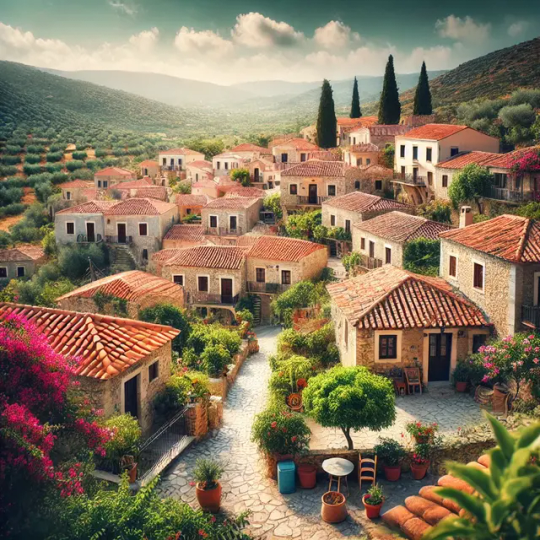
Nestled in the lush landscape of Crete, Gavalohori is a picturesque village that promises visitors an authentic Cretan experience. This charming village, located in the Apokoronas region, is a treasure trove of history, culture, and natural beauty. With its traditional stone houses, narrow cobblestone streets, and vibrant bougainvillea, Gavalohori offers a serene escape from the hustle and bustle of modern life. This blog will take you on a journey through the village's rich history, cultural landmarks, and the unique experiences it has to offer.
Historical Significance
Gavalohori boasts a rich history that dates back to ancient times. The village is named after the Gavalas family, who were prominent landowners during the Venetian period. The area is dotted with archaeological sites that tell the story of its past inhabitants, from the Minoan era to the Byzantine period.
One of the key historical landmarks in Gavalohori is the Venetian wells, a series of stone-built wells that were constructed during the Venetian rule in the 16th century. These wells, located in the center of the village, were an essential water source for the local community. Today, they stand as a testament to the village's historical significance and are a popular attraction for visitors.
Another notable historical site is the Agios Pavlos Church, a beautiful Byzantine church that dates back to the 11th century. The church is adorned with stunning frescoes and icons, providing a glimpse into the religious heritage of the region. Visit GAVALOCHORI.
Cultural Landmarks
Gavalohori is home to several cultural landmarks that highlight the village's rich traditions and craftsmanship. The Folklore Museum of Gavalohori is a must-visit for anyone interested in learning about the local culture. Housed in a traditional stone building, the museum showcases a collection of artifacts, including traditional clothing, tools, and household items. The exhibits provide an insight into the daily lives of the villagers and the customs that have been passed down through generations.
Another cultural gem is the Women's Cooperative of Gavalohori, where local women create and sell handmade crafts. Visitors can watch the artisans at work and purchase unique souvenirs such as embroidered linens, woven textiles, and traditional Cretan lace. The cooperative not only preserves traditional crafts but also supports the local economy and empowers women in the community.
Natural Beauty
The natural beauty of Gavalohori is one of its most captivating features. Surrounded by rolling hills, olive groves, and vineyards, the village offers stunning views of the Cretan countryside. The area is perfect for hiking and nature walks, with several trails that lead through picturesque landscapes and ancient ruins.
One of the most popular hiking routes is the path to the nearby Douliana village. This scenic trail takes you through lush greenery, offering breathtaking views of the surrounding hills and valleys. Along the way, you'll encounter traditional stone houses, old chapels, and the occasional herd of goats grazing in the fields.
Gavalohori is also close to several beautiful beaches, making it an ideal base for exploring the coast of Crete. The nearest beach, Almyrida, is just a short drive away and offers crystal-clear waters and soft sandy shores. Other nearby beaches include Kalyves and Georgioupolis, each with its own unique charm and attractions.
Authentic Cretan Cuisine
No visit to Gavalohori would be complete without indulging in the local cuisine. The village is home to several traditional tavernas and cafes where you can savor authentic Cretan dishes made with fresh, locally sourced ingredients. From succulent lamb dishes to hearty vegetable stews, the flavors of Crete are sure to delight your taste buds.
One of the signature dishes of the region is dakos, a traditional Cretan salad made with barley rusks, ripe tomatoes, feta cheese, and a drizzle of olive oil. Another local favorite is kalitsounia, small pastries filled with cheese or wild greens and herbs. These delicious treats are often enjoyed with a glass of raki, a traditional Cretan spirit made from distilled grapes.
For a truly immersive culinary experience, consider taking a cooking class with a local chef. Many villagers are happy to share their family recipes and cooking techniques, giving you the opportunity to learn how to prepare authentic Cretan dishes in a traditional kitchen setting.
Festivals and Events
Gavalohori is known for its vibrant festivals and events, which offer a glimpse into the village's rich cultural heritage. One of the most popular events is the annual Easter celebration, which includes traditional music, dancing, and feasting. The village comes alive with colorful decorations and lively processions, creating a festive atmosphere that is enjoyed by locals and visitors alike.
Another significant event is the Feast of the Holy Spirit, held 50 days after Easter. This religious festival includes a church service, followed by a communal meal and traditional music and dancing. It's a wonderful opportunity to experience the warmth and hospitality of the local community.
Throughout the year, Gavalohori also hosts various cultural events, including art exhibitions, craft fairs, and music concerts. These events showcase the talents of local artists and musicians, providing a platform for them to share their work with a wider audience.
Accommodation and Visitor Information
Gavalohori offers a range of accommodation options to suit different preferences and budgets. From charming guesthouses and traditional stone villas to modern apartments and boutique hotels, there's something for everyone. Many of the accommodations are family-run, providing a warm and welcoming atmosphere that makes you feel right at home.
When planning your visit to Gavalohori, it's a good idea to check the local weather conditions and pack accordingly. The village enjoys a Mediterranean climate, with hot, dry summers and mild, wet winters. Spring and autumn are ideal times to visit, as the weather is pleasant and the landscape is lush and green.
To make the most of your stay, consider renting a car, as it will give you the freedom to explore the surrounding areas at your own pace. The village is well-connected by road, and there are several car rental agencies in the nearby town of Chania.
Conclusion
Gavalohori is a hidden gem that offers an authentic Cretan experience for those who seek to explore the island's rich history, culture, and natural beauty. With its charming stone houses, vibrant cultural landmarks, and stunning landscapes, the village is a perfect destination for travelers looking to immerse themselves in the traditions and hospitality of Crete. Whether you're wandering through its cobblestone streets, savoring the local cuisine, or participating in a lively festival, Gavalohori promises an unforgettable journey that will leave you with lasting memories of this enchanting corner of Crete.
Visiting Gavalohori is like stepping back in time, where the simplicity of village life and the warmth of the local community create an atmosphere of tranquility and joy. So, pack your bags and embark on a journey to Gavalohori, where the heart of Crete beats strongest and the spirit of the island comes alive in every corner.
0 notes
Text
The Allure of Gavalohori: Unveiling Crete's Best-Kept Secret

Nestled in the picturesque hills of western Crete, Gavalohori is a village that encapsulates the essence of traditional Greek charm. This hidden gem, often overlooked by the throngs of tourists, offers a unique glimpse into the island's rich history, culture, and natural beauty. From its cobblestone streets and stone-built houses to its vibrant local traditions and stunning landscapes, Gavalohori is a treasure trove waiting to be discovered.
A Historical Tapestry
The Origins of Gavalohori
Gavalohori is named after the Gavalas family, who were prominent during the Venetian occupation of Crete. The village's history, however, stretches back much further, with archaeological findings indicating settlements dating to the Minoan period. These deep historical roots are visible in the architecture and layout of the village, providing a living museum for those interested in Crete's past.
Architectural Heritage
Walking through Gavalohori, visitors are greeted by a blend of Venetian, Turkish, and Greek architectural influences. The village is renowned for its well-preserved stone houses with red-tiled roofs and ornate doorways. One of the most notable buildings is the old olive oil factory, now serving as a museum that showcases traditional methods of olive oil production. The narrow, winding streets lead to charming squares where locals gather, offering a snapshot of daily life in a bygone era. Visit GAVALOCHORI.
The Cultural Heartbeat
Local Traditions and Crafts
Gavalohori is not just a village frozen in time; it is a vibrant community that keeps its traditions alive. One of the most celebrated aspects of local culture is the art of lace-making. The women of Gavalohori have been producing intricate, hand-made lace for generations, a craft known locally as "kopaneli." This skill is passed down from mother to daughter, and visitors can witness the meticulous process in various workshops scattered throughout the village.
Festivals and Celebrations
The village calendar is dotted with festivals and celebrations that offer a deeper understanding of local customs. The feast of Agios Georgios (St. George), the village's patron saint, is particularly significant. Celebrated with processions, music, and traditional dances, it is a highlight for both locals and visitors. These events are a testament to the strong community spirit and the importance of cultural heritage in Gavalohori.
Natural Beauty and Outdoor Adventures
Exploring the Surrounding Landscape
Gavalohori is blessed with a stunning natural setting that invites exploration. The village is surrounded by olive groves, vineyards, and rolling hills, making it an ideal starting point for nature walks and hikes. One popular route is the trail to the nearby village of Douliana, which takes hikers through lush landscapes and offers breathtaking views of the Cretan countryside.
Beaches and Coastal Delights
While Gavalohori itself is inland, it is just a short drive from some of Crete's most beautiful beaches. Almyrida and Kalyves are two nearby coastal towns that boast pristine sandy shores and crystal-clear waters. These beaches are perfect for swimming, sunbathing, and enjoying water sports. After a day by the sea, returning to the tranquility of Gavalohori provides a perfect balance.
Gastronomic Delights
Traditional Cretan Cuisine
No visit to Gavalohori would be complete without indulging in the local cuisine. The village's tavernas and eateries serve up traditional Cretan dishes that are a feast for the senses. From hearty lamb stews and fresh seafood to an array of mezes (small dishes) featuring locally sourced vegetables, cheese, and olives, the food in Gavalohori is a highlight in its own right.
Olive Oil and Wine
The surrounding region is also known for its excellent olive oil and wine. Many local families produce their own olive oil, using methods that have been passed down through generations. Similarly, the vineyards around Gavalohori produce wines that reflect the unique terroir of Crete. Tasting these products provides a deeper appreciation of the village's agricultural heritage.
Staying in Gavalohori
Accommodation Options
Gavalohori offers a range of accommodation options that cater to different tastes and budgets. Traditional guesthouses and villas provide a charming and comfortable stay, allowing visitors to immerse themselves in the village atmosphere. Many of these accommodations are housed in beautifully restored historic buildings, offering a unique blend of old-world charm and modern amenities.
Sustainable Tourism
The village is committed to promoting sustainable tourism practices. Efforts are made to preserve the natural environment and cultural heritage while providing authentic experiences for visitors. Staying in Gavalohori supports the local economy and helps maintain the traditional way of life that makes the village so special.
Practical Tips for Visitors
Getting There
Gavalohori is easily accessible from Chania, the nearest major city. The village is approximately a 45-minute drive from Chania International Airport. Renting a car is the most convenient way to explore the region, but public transportation options are also available for those who prefer not to drive.
Best Time to Visit
While Gavalohori is beautiful year-round, the best time to visit is during the spring and autumn months. The weather is pleasant, and the village is less crowded than in the peak summer season. These periods also coincide with local festivals and the blooming of wildflowers, adding to the charm of the visit.
Language and Communication
Greek is the official language, but English is widely spoken, especially in the hospitality industry. Learning a few basic Greek phrases can enhance the experience and is always appreciated by the locals.
Conclusion
Gavalohori is a destination that captivates with its blend of history, culture, and natural beauty. It offers a peaceful retreat from the busier tourist spots while providing a rich tapestry of experiences. Whether you're wandering its ancient streets, partaking in local traditions, or exploring the surrounding landscapes, Gavalohori promises an unforgettable journey into the heart of Crete. This best-kept secret invites travelers to slow down, savor the moment, and discover the timeless allure of a village that has preserved its soul through the centuries.
0 notes